|
Smother'd in
Surmise
— Edward de Vere — Card Games Dans les champs de l'observation le hasard ne favorise que les esprits préparés. In the fields of observation chance favors only the prepared mind. Louis Pasteur, December 1854. Diligence is the mother of good luck. Benjamin Franklin, 1758. seek, and ye shall find; knock, and it shall be opened unto you: Matt 7: 7 Gucki Grand. This is also called guckser. The player declares Grand (jacks trumps), and forthwith picks up the skat. (Taking both cards of the skat, without remark, is equivalent to declaring gucki grand.) He discards two cards, which will be added to his tricks after the play. When a gucki contract is not fulfilled, the loss is doubled. According to Hoyle, Richard L. Frey
Claim 3) Evidence for de Vere as the author of the Sonnets is encrypted in the dedication.
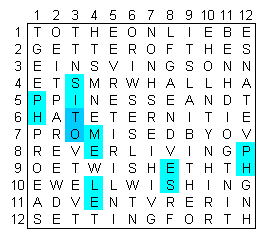 Grid 12, MEPHISTOPHELES For me the most intriguing aspect of Jonathan Bond's work and that of others, in particular that of James, Leyland and Goding, is to attempt to place some estimate on the value of the messages derived from the decryption process. Brenda James provided some independent text which permitted Drystone to test it for hidden messages and thus get some rude estimate of the probability of such messages occurring by chance. Bond however provides us, via Rollett, with a rare item indeed – a numeric estimate of probabilities. Rollet calculated the odds of a 5 letter name turning up in one of the 144 grids as about 1000:1.(JB61) This probability value can be tested empirically. We take the dedication and look for names (beside Henry and Wriothesley) that occur in the grids. With a predicted probability of 1 in a 1000 we would expect to find none or perhaps one. We find in various grids: BEN, SEAN, NORA, NOEL, TANNER, LANE – a little dull, and only one name is more than 4 letters. 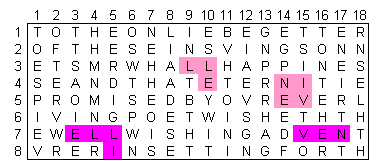 Grid 18, NEVILLE, NEVILLE So let's wind the wick up a little, consider MEPHISTOPHELES (grid 12) or NEVILLE and NEVILLE again! (grid 18). (I'm quite chuffed with these NEVILLEs, they are better than the ones the Nevillians found!) 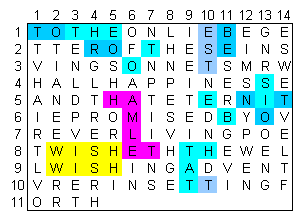 Grid 14, HAMLET If the odds are 1:1000 for any five letter name occurring, then what are the chances of a name of a Shakespearean play arising. Well not too long apparently, because we have we have HAMLET (grid 14) and LEAR (grid 10) and of course Cleopatra. 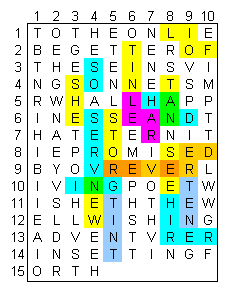 Grid 10, LEAR "Cleopatra? Now I know you're joshing me, Drystone 'cos there ain't no C in the dedication."
Well, look at grid 19 – THE NILE IS HER NILE TO REVERE. In Antony and Cleopatra Act I Scene V Cleopatra muses over Antony
musing about her. This grammatically correct message in grid 19, reading left to right, with two occurrences of NILE is clearly indicating Cleopatra. While we are doing messages let's look back at the HAMLET grid. We can find our way through TO BE OR NOT TO BE, THAT IS THE TEST 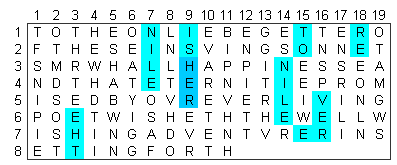 Grid 19, Cleopatra "'Test'? What happened to 'question'?" Well, here we should introduce some argument about the appropriateness of 'test', perhaps drawing from the use of test as assay – "not with fond shekels of the tested gold" (Measure for Measure). Of course, as a casual speaker might say if she noted another part of the same grid presenting one WISH stacked directly on top of another, "that is just so Hamlet." Is there anything in the LEAR grid of significance? There are words, HE, HEW, HIRE, HIRER, NEW, NIT, REVERED, SERVING, SHE, SO, STORE, TAN, TEN, TIN, TINT, WE, but I can't devise a message pertaining to Lear. Perhaps an ounce of civet would help. Clearly the chances of finding names (and messages) is higher than what Rollet proposed – we have found so many names that on his figures this situation would amount to an extraordinarily rare event. In truth, instead of a name occurring in text subject to the grid process being an exceptional event, the inverse is true – the exception would be if no names occurred. And I imagine that there is more material in the grids, particularly names, as it is difficult to be systematic when searching for fragmented data. I suspect I found the NEVILLEs because I had recently been looking over the Neville material elsewhere on this site. MEPHISTOPHELES is also a favourite of mine from the Neville pages. If you wish to theorise on long odds consider that MEPHISTOPHELES appeared when the dedication to the Sonnets was decoded along the lines defined by Bond and it also appeared when the sample dedication provided by James – a different text – was decoded along the lines defined by James, Leyland and Goding. (DS252). I believe the first three quotations at the head of this section are relevant; in a jumble of letters we tend to find what we are seeking and what we have in our minds.
Summary of incidentals (decryptions not in the de Vere hypothesis) to date
General names: (various grids) BEN, SEAN, NORA, NOEL, TANNER, LANE, NEVILLE (twice) Shakespearean names (grid 14) HAMLET with supporting text TO BE OR NOT TO BE THAT IS THE TEST (grid 10) LEAR with potential supporting text drawn from HE, HEW, HIRE, HIRER, NEW, NIT, REVERED, SERVING, SHE, SO, STORE, TAN, TEN, TIN, TINT, WE (grid 19) Cleopatra indicator THE NILE IS HER NILE TO REVERE And the Drystone Self-indulgent Award is granted – for the longest word, (14 letters) (Wriothesley has 11), for being present in a perfect square grid, and for occurring in two totally independent text decryptions – to MEPHISTOPHELES. Stuck with your laptop at an airport? Download the grids and as in-flight entertainment see what new decryptions you can turn up – grids in Excel format. 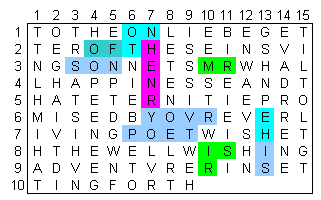 Grid 15, other words on the HENRY grid Now to look at the girds in the The De Vere Code. Bond introduces the reader to the transition ciphers with grid 15. The name HENRY is clear and roughly centrally placed. However, what else is on the grid? We can identify at least ON, OF, SON, MR, YOUR, POET, HE, IS and SIR. There is scope for messages here, variations of SON OF SIR/MR HENRY HE IS YOUR POET that deserve consideration, but let's move on. The next grid in that Bond examines, grid 18, (JB62) contains the message: TO OFT ESPIE WRIOTHESLEY WIT NEED NOT HERE TRIE. It's a worthy message (the HER+E is not in good form, but then you could leave it out if you like). However there are some alternative messages available. The same grid also contains two NEVILLEs (DS115) so I guess the question is (it's like some crazy card game), do two NEVILLEs beat one WRIOTHESLEY? Perhaps the message is TO OFT ESPIE NEVILLE WIT NEED NOT HERE TRIE, or conceivably TO OFT ESPIE WRIOTHESLEY NEVILLE NEED NOT HERE TRIE or (and I bet you have guessed already ;-) TO OFT ESPIE NEVILLE WRIOTHESLEY NEED NOT HERE TRIE. There are a few other words available in the same grid – NO, SIR, SO, YOU, .. – so other messages are available. For example, YOU NEED NO WIT TO ESPIE NEVILLE. It is, as mentioned in the Drystone Introduction (DS010), a weakness of the grid system that messages can be corrupted by incidentals. For the decrypter, there is no way – other than double guessing the sender – to determine what was intended and what was not. Nevertheless, if we accept for grid 18:
that a message has been encrypted in the dedication using the grid system,
then the result is – "if you look you will find Wriothesley in these sonnets."
that we ignore the two NEVILLEs and other incidentals and that Bond's selection of a message is correct That is no revelation; a person with copies of the dedication to Lucrece (DS153) and the Sonnets to hand could well believe (correctly or incorrectly) that Shakespeare targeted Wriothesley with some of the sonnets. It hardly seems worth anyone's trouble to encrypt it. It is a difficulty, identified in the Hercule Poirot comments (DS005) that since the diamond is not to be found in the bowl of the unsmoked pipe evidence must be piled on evidence to constitute a "proof". Although we have discovered that there are more things in the dedication than are dreamt of in a decrypter's philosophy, only a limited number of decrypted words can be put to any particular service. The champion of a candidate must ultimately look elsewhere for evidence. The Sonnets themselves are irresistible – 154 poems, 2156 lines, 17,000 words. Once there, we are in a land overflowing with potential for numerology and conjecture. Bond takes us there and the arguments he presents should be evaluated. However(1), to chase every(2) rabbit down whatever(3) burrow that it darted into would serve(4) little purpose and could take forever(5); nevertheless(6) we should give some consideration to the topic so we will revert(7) to examining the grid that led us there. (The numbered words in the previous sentence are v,e,r,e words, to some extent relevant to a word count argument introduced by Bond (JB68). I can sympathise with the Stratfordians; imagine trying to find a set of s,h,a,k,e,s,p,e,a,r,e words. Though, for what it's worth, searches within the Sonnets for the sequences 'shake' and 'vere' each return 5 occurrences.)
The decryption message that leads us, Bond explains, to Sonnet 116 is: LET ROSIE LIP POET APE OWN
Only a couple of comments. The inclusion of POET is interesting. It is not, of course, a decryption but simply one of the original words in the dedication. By accepting its validity in this message Bond validates the use of any of the words in the dedication to form a message. Thus the Nevillians could argue that a valid reading of grid 15 is SIR HENRY IS YOUR POET (DS122). The presence of LIP, rather than LIPS as a match to Sonnet 116 requires, is inconsistent with the existence of a Grand Encrypter, who despite his demonstrated prowess elsewhere, seemingly cannot pluralize LIP. Some plural nouns, 'tempests' a few lines earlier in the same sonnet for example, would not suffer from a conversion to singular, but ROSIE LIP is particularly clumsily – a face with a single rosie lip is indeed Time's foole.  SETTING FORTH, TWELVE, rows 9,10,11,12 Drystone has discovered its own sonnet links. I glanced at Sonnet 115 (Those lines that I before have writ do lie) which was at he head of the page containing Sonnet 116. Line 7 is Tan sacred beauty, blunt the sharp'st intents. Tan appears only once in the sonnets. It also appears in the "Lear" grid (DS117). Presumably Lear is the king in
My most full flame should afterwards burn clearer.
There is lot of scope for conjecture in Sonnet 115.
But reckoning Time, whose million'd accidents Creep in 'twixt vows, and change decrees of kings, Tan sacred beauty, blunt the sharp'st intents, During the investigation of the 148 character based Neville claim I accidentally discovered a message in line 10 of Sonnet 4 that supported an argument I was pursuing. For an exercise I tried to reach the same place with the Bond 144 character layout. Arguably a pointer to Sonnet Four is provided by the words SETTING FORTH. (Reading forth as fourth is amply endorsed by Bond.(JB50,52,53)) I was pleased to find that in "the most obvious perfect rectangle of all – the 12 by 12 square" (JB79) SETTING FORTH entirely occupied row 12. If there were to be further pointers they would be in this grid. Since SETTING FORTH is on row/line 12 of the grid an interpretation would be line 12 of the sonnet. Since lines 10 and 12 rhyme the argument could carry that line 10 (my original target) is also intended. However the proposal that row 12 means line 12 seemed a little soft. Then my doubts were resolved for very neatly placed in the preceding rows was TWELVE. Still if I'm to use a rhyming based argument I should argue for the quatrain that line 12 concludes. Again any doubts were resolved when I noticed that clues in the grid were neatly placed in rows 9, 10, 11 and 12 corresponding to lines 9, 10, 11 and 12 – the last quatrain in the sonnet. The nature of a quatrain is like a paragraph in prose, it contains a coherent thought and readily adapts to a message. So the outcome of my decryption (frankly, better than I intended) is:
For having traffic with thy self alone,
or freely translated, a clear indication that there is nothing for a researcher to find,
Thou of thy self thy sweet self dost deceive: Then how when nature calls thee to be gone, What acceptable audit canst thou leave?
Working on your own
You deceive yourself in expecting to find anything here. That said, when you are dead and gone, What of note can you expect to leave? Of course, Drystone has little faith in the two decryptions (pointers to Sonnet 115 and Sonnet 4) above. (But how, particularly if they were dressed up somewhat, would a skeptic prove they weren't genuine – careful, circular arguments are not accepted.) I have included these two decryptions as a reminder of the Drystone wall effect – given a big enough pile of stones, a particular stone can be found that, perhaps with a little juggling, will fit the current requirement, and the wall will progress. TAN was stone that fitted neatly into the "only time the word is used in the sonnets hole." I wanted my wall to reach a certain point and I found SETTING FORTH, TWELVE and their particular placement within the grid to lead me there. In the Epilogue to the de Vere section of Drystone there is a further example of the "seek and ye shall find effect." Mal Haysom initial posting 22/06/2011 last update November 6, 2015 |